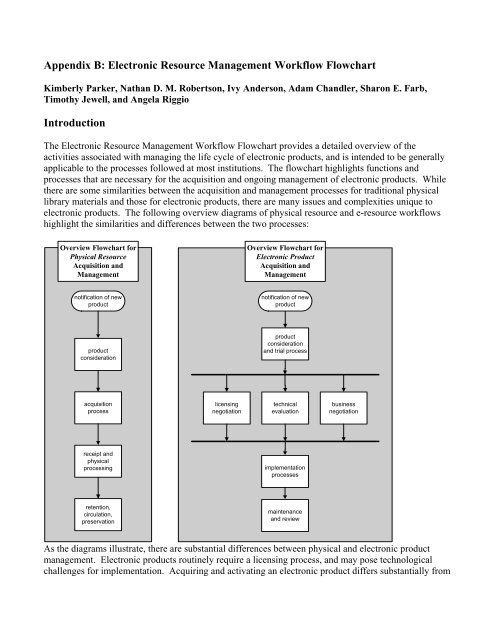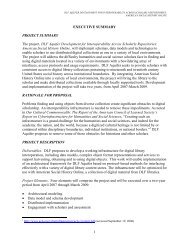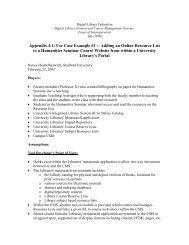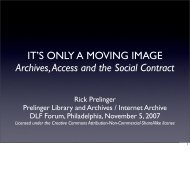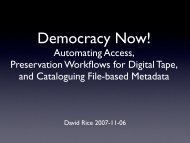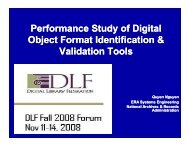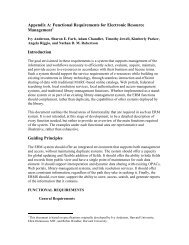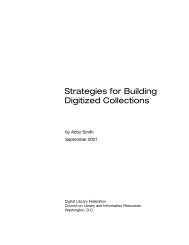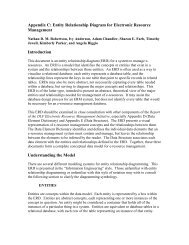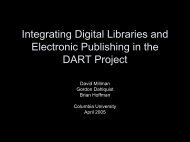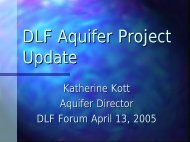Appendix B: Electronic Resource Management Workflow Flowchart
Appendix B: Electronic Resource Management Workflow Flowchart
Appendix B: Electronic Resource Management Workflow Flowchart
Create successful ePaper yourself
Turn your PDF publications into a flip-book with our unique Google optimized e-Paper software.
<strong>Appendix</strong> B: <strong>Electronic</strong> <strong>Resource</strong> <strong>Management</strong> <strong>Workflow</strong> <strong>Flowchart</strong>Kimberly Parker, Nathan D. M. Robertson, Ivy Anderson, Adam Chandler, Sharon E. Farb,Timothy Jewell, and Angela RiggioIntroductionThe <strong>Electronic</strong> <strong>Resource</strong> <strong>Management</strong> <strong>Workflow</strong> <strong>Flowchart</strong> provides a detailed overview of theactivities associated with managing the life cycle of electronic products, and is intended to be generallyapplicable to the processes followed at most institutions. The flowchart highlights functions andprocesses that are necessary for the acquisition and ongoing management of electronic products. Whilethere are some similarities between the acquisition and management processes for traditional physicallibrary materials and those for electronic products, there are many issues and complexities unique toelectronic products. The following overview diagrams of physical resource and e-resource workflowshighlight the similarities and differences between the two processes:Overview <strong>Flowchart</strong> forPhysical <strong>Resource</strong>Acquisition and<strong>Management</strong>Overview <strong>Flowchart</strong> for<strong>Electronic</strong> ProductAcquisition and<strong>Management</strong>notification of newproductnotification of newproductproductconsiderationproductconsiderationand trial processacquisitionprocesslicensingnegotiationtechnicalevaluationbusinessnegotiationreceipt andphysicalprocessingimplementationprocessesretention,circulation,preservationmaintenanceand reviewAs the diagrams illustrate, there are substantial differences between physical and electronic productmanagement. <strong>Electronic</strong> products routinely require a licensing process, and may pose technologicalchallenges for implementation. Acquiring and activating an electronic product differs substantially from
Notes1. A decision to “proceed” indicates that the product’s content has been evaluated duringthe preceding consideration process and a serious effort to acquire the product shouldbegin.2. While the parallel processes represented on page 2 are shown as following after a trialperiod if one takes place, in some cases the parallel processes may begin during the trialperiod if one is held, and the trial will assist in answering questions raised during theparallel review processes.3. “Technically feasible?” represents a review of whether the product will functionwithout difficulty within the institution’s technical environment, or, if not, whether anacceptable level of effort will allow the product to function.4. “Business issues” embodies an extensive list of important concepts. Among the itemsthat might be investigated in this grouping are: price, archival needs, interface trajectory,vendor quality, branding capability, usage statistics, MARC record availability and price(if appropriate), instructional ports/accounts (if appropriate), OpenURL compliance,deep-linking capability, etc.5. It is entirely possible that the license will already be signed by this point, or that thelicense signing process is completely divorced from the order process. The“order/register/formally sign license” action point is completed when the institution hasformally committed to acquiring the product in every way necessary.6. The action of notifying catalogers and service administrators (e.g. proxy servermanager, OpenURL resolver manager, broadcast search service manager, etc.) may occurat any number of points. This item was placed early in the workflow diagram toemphasize that some products are problematic for service managers and early notificationis often very beneficial.7. “Routine product maintenance” encompasses a large array of functions not detailedhere. Among the functions included in this concept are the capture of usage statistics,troubleshooting and resolving problems, routine product changes from the vendor (suchas URL revisions), revisions to public documentation, etc.8. “Product review” on page 4 is simply a truncated form of the review of a new productthat occurs on page 2. The extent of the review may vary from product to product andfrom institution to institution.


